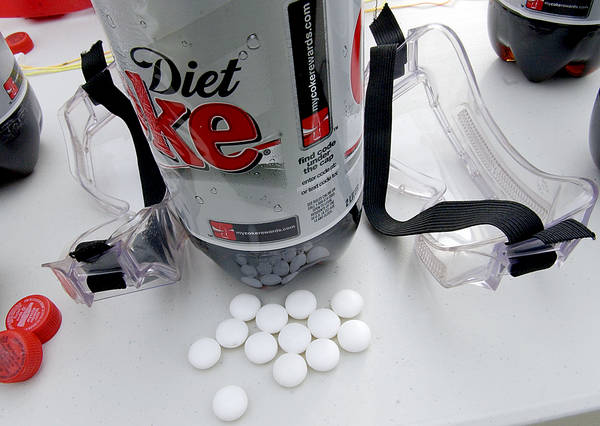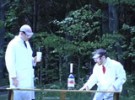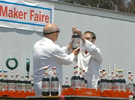
The Science of Coke and Mentos
Try This at Home!
You've Seen the Videos, Get the Book Air Cannons, Magnet Motors, and 25 Other Amazing DIY Science Projects
Air Cannons, Magnet Motors, and 25 Other Amazing DIY Science Projects
The Viral Video Manifesto
Get Our Book on What Makes Videos Go Viral "Voltz and Grobe have deciphered the magic of making viral videos."
"Voltz and Grobe have deciphered the magic of making viral videos."
—Stafford Green, The Coca-Cola Company
How Does This Work?
Why do Diet Coke & Mentos and Coke Zero & Mentos create such exciting geysers?
It’s mostly due to a process called nucleation, where the carbon dioxide in the soda is attracted to the Mentos (they are awfully cute). That creates so much pressure that the soda goes flying. We then built nozzles that make the opening smaller and that makes the geysers go even higher.
So what is nucleation about and why do Mentos release all this pressure so spectacularly? Read on…
Making Lots of Bubbles
After a lot of debate, scientists are now saying that the primary cause of Coke & Mentos geysers is a physical reaction, not a chemical reaction. Their explanation is this process called nucleation.
All the carbon dioxide in the soda – all that fizz – is squeezed into the liquid and looking for a way out. It’s drawn to any tiny bumps that it can grab onto. Those tiny bumps are called nucleation sites: places the gas can grab onto and start forming bubbles.
Nucleation sites can be scratches on a glass, the ridges of your finger, or even specks of dust – anywhere that there is a high surface area in a very small volume.
The surface of a Mentos is sprayed with over 40 microscopic layers of liquid sugar. That makes it not only sweet but also covered with lots and lots of nucleation sites.
In other words, there are so many microscopic nooks and crannies on the surface of a Mentos that an incredible number of bubbles will form around the Mentos when you drop it into a bottle of soda.
Since the Mentos are also heavy enough to sink, they react with the soda all the way to the bottom. The escaping bubbles quickly turn into a raging foam, and the pressure builds dramatically.
All that pressure has got to go somewhere, and before you know it, you've got a big geyser happening!
Try This at Home!
This is a great thing to try yourself – if you’re careful. Here’s how. Make sure you wear your goggles and lab coats, so that you are not only protected, you also look cool as you run away from the flying soda.
The Big Question
What happens if you drink soda and then eat Mentos? Well, a lot of the fizz goes away as you drink. Then when bubbles are released in your stomach, your stomach can expand a bit. And your stomach also has ways of, umm, releasing excess gas… The MythBusters showed that your stomach won’t explode, but it still wouldn’t be a lot of fun. Do not, repeat, do not be stupid and test the limits of your stomach. Don't even think about it.
What Else Works?
We've tested everything from Mountain Dew & Lifesavers to Moxie & M&M's. Shockingly enough, dropping just about anything into just about any kind of soda creates at least a little fizz. Even some pocket change made a bottle of root beer bubble up a bit. But the combination of Coke Zero & Mentos is particularly potent!
Does It Have to be Diet?
Diet Coke and Coke Zero tend to go a bit higher than regular soda, because they have a little more carbonation and the sweeteners help make the reaction a little bigger. Most importantly, Coke Zero and Diet Coke aren’t sugary and sticky. Every time we set off a big geyser display, we get soaked to the skin, so it’s nice not to get covered in sugary goo.
Interesting Links
Thanks to Tonya Coffey at Appalachian State University in North Carolina for publishing a scientific study of Coke & Mentos in the American Journal of Physics. New Scientist has this great summary of the explanation.
Fun with Nucleation
You can learn more about nucleation sites in action if you coat the inside of a small glass with vegetable oil. Move the glass around to get a nice smooth coating of oil and then pour in some soda. What happens? No fizz. Why? No nucleation sites. Now sprinkle in some granulated sugar. What happens? Lots of fizz! Why? Lots of nucleation sites!









